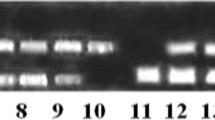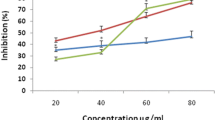Abstract
Caralluma adscendens (Roxb.) Haw var. fimbriata (wall.) Grav. & Mayur. is a traditional food consumed as vegetable or pickle in arid regions of India and eaten during famines. In Indian traditional medicine, the plant is used to treat diabetes, inflammation and etc. The aim of this study was to evaluate the antioxidant properties (DPPH, TEAC, TAA, FRAP, OH˙ and NO˙ radical scavenging activities) of the different extracts from aerial parts. The levels of total phenolics and flavonoids of the extracts were also determined. The extracts were found to have different levels of antioxidant properties in the test models used. Methanol and water extracts had good total phenolic and flavonoid contents showed potent antioxidant and free radical scavenging activities. The antioxidant activity was correlated well with the amount of total phenolics present in the extracts. The extracts and its components may be used as an additive in food preparations and nutraceuticals.

Similar content being viewed by others
References
Ahn GN, Kim KN, Cha SH, Song CB, Lee J, Heo MS, Yeo IK, Lee NH, Jee YH, Kim JS, Heu MS, Jeon YJ (2007) Antioxidant activities of phlorotannins purified from Ecklonia cava on free radical scavenging using ESR and H2O2-mediated DNA damage. Eur Food Res Technol 226:71–79
Ansari NM, Houlihan L, Hussain B, Pieroni A (2005) Antioxidant activity of five vegetables traditionally consumed by South-Asian Migrants in Bradford, Yorkshire, UK. Phytother Res 19:907–911
AOAC (1990) Official methods of analysis, 14th edn. Washington DC, USA
Atal CK, Sharma BM, Bhatia AK (1980) Search of emergency foods through wild flora of Jammu and Kashmir state: Sunderbani area -1. Indian Forester 106:211–219
Benzie IFF, Strain JJ (1996) The ferric reducing ability of plasma (FRAP) as a measure of “antioxidant power”: the FRAP assay. Anal Biochem 239:70–76
Dastmalchi K, Dorman HJD, Oinonen PP, Darwis Y, Laakso I, Hiltunen R (2008) Chemical composition and in vitro antioxidative activity of a lemon balm (Melissa officinalis L.) extract. LWT- Food Sci Technol 41:391–400
Dorman HJD, Kosar M, Kahlos K, Holm Y, Hiltunen R (2003) Antioxidant properties and composition of aqueous extracts from Mentha species, hybrids, varieties, and cultivars. J Agric Food Chem 51:4563–4569
Dudonne S, Vitrac X, Coutiere P, Woillez M, Merillon JM (2009) Comparative study of antioxidant properties and total phenolic content of 30 plant extracts of industrial interest using DPPH, ABTS, FRAP, SOD, and ORAC assays. J Agric Food Chem 57:1768–1774
Egea I, Sánchez-Bel P, Romojaro F, Pretel MT (2010) Six edible wild fruits as potential antioxidant additives or nutritional supplements. Plant Foods Hum Nutr 65:121–129
Garrat DC (1964) The quantitative analysis of drugs, 3rd vol. Chapman and Hall Ltd, Japan, pp 456–458
Hagerman AE, Riedl KM, Jones GA, Sovik KN, Ritchard NT, Hartzfeld PW (1998) High molecular weight plant polyphenolics (tannins) as biological antioxidants. J Agric Food Chem 46:1887–1892
Hassan LG, Umar KJ (2006) Nutritional value of Balsam apple (Momordica balsamina L.) leaves. Pak J Nutr 5:522–529
Hayouni EA, Abedrabba M, Bouix M, Hamdi M (2007) The effects of solvents and extraction method on the phenolic contents and biological activities in vitro of Tunisian Quercus coccifera L. and Juniperus phoenicea L. fruit extracts. Food Chem 105:1126–1134
Heo SJ, Park EJ, Lee KW, Jeon YJ (2005) Antioxidant activities of enzymatic extracts from brown seaweeds. Bioresour Technol 96:1613–1623
Ishida Y, Fujita T, Asai K (1981) New detection and separation method for amino acids by high performance liquid chromatography. J Chromat 204:143–148
Jung CH, Seog HM, Choi IW, Park MW, Cho HY (2006) Antioxidant properties of various solvent extracts from wild ginseng leaves. LWT- Food Sci Technol 39:266–274
Klein SM, Cohen G, Cederbaum AI (1991) Production of formaldehyde during metabolism of dimethyl sulphoxide by hydroxyl radical generating system. Biochemistry 20:6006–6012
Kubola J, Siriamornpun S (2008) Phenolic contents and antioxidant activities of bitter gourd (Momordica charantia L.) leaf, stem and fruit fraction extracts in vitro. Food Chem 110:881–890
Kumaran A, Karunakaran RJ (2006) Antioxidant and free radical scavenging activity of an aqueous extract of Coleus aromaticus. Food Chem 97:109–114
Kunert O, Rao VG, Babu GS, Sujatha P, Sivagamy M, Anuradha S, Rao BVA, Kumar BR, Alex RM, Schuehly W, Kuehnelt D, Rao GV, Rao AVNA (2008) Pregnane glycosides from Caralluma adscendens var. fimbriata. Chem Biodiv 5:239–250
Leong LP, Shui G (2002) An investigation of antioxidant capacity of fruits in Singapore markets. Food Chem 76:69–75
Mali KK, Dias RJ, Hawaldar VD, Mahajan NS (2009) Hypoglycemic activity of Caralluma adscendens in alloxan induced diabetic rats. Int J Chem Sci 7:517–522
Mao LC, Pan X, Que F, Fang XH (2006) Antioxidant properties of water and ethanol extracts from hot air-dried and freeze-dried daylily flowers. Eur Food Res Technol 222:236–241
Marwah RG, Fatope MO, Mahrooqi RA, Varma GB, Abadi HA, Al-Burtamani SKS (2007) Antioxidant capacity of some edible and wound healing plants in Oman. Food Chem 101:465–470
Narasinga Rao BS, Deosthale YG, Pant KC (1989) Nutritive value of Indian Foods. National institute of nutrition, Indian Council of Medical Research, Hyderabad, India
Olaofe O, Akintayo ET (2000) Production of isoelectric points of legume and oil seed proteins from their amino acid composition. J Technol Sci 4:49–53
Ordon Ez AAL, Gomez JD, Vattuone MA, Isla MI (2006) Antioxidant activities of Sechium edule (Jacq.) Swart extracts. Food Chem 97:452–458
Prieto P, Pineda M, Aguilar M (1999) Spectrophotometric quantitation of antioxidant capacity through the formation of a phosphomolybdenum complex, Specific application to the determination of vitamin E. Anal Biochem 269:337–341
Pyo YH, Lee TC, Logendra L, Rosen RT (2004) Antioxidant activity and phenolic compounds of Swiss chard (Beta vulgaris subspecies cycla) extracts. Food Chem 85:19–26
Re R, Pellegirini N, Proteggente A, Pannala A, Yang M, Rice-Evans C (1999) Antioxidant activity applying an improved ABTS radical cation decolorization assay. Free Radic Biol Med 26:1231–1237
Santas J, Carbo R, Gordon MH, Almajano MP (2008) Comparison of the antioxidant activity of two Spanish onion varieties. Food Chem 107:1210–1216
Sfahlan AJ, Mahmoodzadeh A, Hasanzadeh A, Heidari R, Jamei R (2009) Antioxidants and antiradicals in almond hull and shell (Amygdalus communis L.) as a function of genotype. Food Chem 115:529–533
Shahidi F (1997) Natural antioxidants, chemistry, health effects and applications. AOCS Press, Champaign
Shukla S, Mehta A, Bajpai VK, Shukla S (2009) In vitro antioxidant activity and total phenolic content of ethanolic leaf extract of Stevia rebaudiana Bert. Food Chemic Toxicol 47:2338–2343
Singh R, Singh S, Kumar S, Arora S (2007) Evaluation of antioxidant potential of ethyl acetate extract/fractions of Acacia auriculiformis A. Cunn. Food Chem Toxicol 45:1216–1223
Singleton V, Orthofer R, Lamuela-Raventos RM (1999) Analysis of total phenols and other oxidation substrates and antioxidants by means of folin-ciocalteu reagent. Methods Enzymol 299:152–178
Sultana B, Anwar F, Przybylski R (2007) Antioxidant activity of phenolic components present in barks of Azadirachta indica, Terminalia arjuna, Acacia nilotica, and Eugenia jambolana Lam. Trees. Food Chem 104:1106–1114
Tatiya AU, Kulkarni AS, Surana SJ, Bari ND (2010) Antioxidant and hypolipidemic effect of Caralluma adscendens Roxb. in alloxanized diabetic rats. Int J Pharmacol 6:362–368
Tavarini S, DeglInnocenti E, Remorini D, Massai R, Guidi L (2008) Antioxidant capacity, ascorbic acid, total phenols and carotenoids changes during harvest and after storage of Hayward kiwifruit. Food Chem 107:282–288
The Wealth of India (1992) A dictionary of Indian raw materials and industrial products. Vedams, New Delhi, pp 266–267
Valento P, Fernandes E, Carvalho F, Andrade PB, Seabra RM, Bastos ML (2002) Antioxidative properties of cardoon (Cynara cardunculus L.) infusion against superoxide radical, hydroxyl radical, and hypochlorous acid. J Agric Food Chem 50:4989–4993
Wang H, Gan D, Zhang X, Pan Y (2010) Antioxidant capacity of the extracts form pulp of Osmathus fragrans and its components. LWT–Food Sci Technol 43:319–325
Acknowledgement
The authors are grateful to the Management, Karpagam Educational Institutions for generous support and encouragement to carry out the study.
Author information
Authors and Affiliations
Corresponding author
Rights and permissions
About this article
Cite this article
Maheshu, V., Priyadarsini, D.T. & Sasikumar, J.M. Antioxidant capacity and amino acid analysis of Caralluma adscendens (Roxb.) Haw var. fimbriata (wall.) Grav. & Mayur. aerial parts. J Food Sci Technol 51, 2415–2424 (2014). https://doi.org/10.1007/s13197-012-0761-5
Revised:
Accepted:
Published:
Issue Date:
DOI: https://doi.org/10.1007/s13197-012-0761-5




